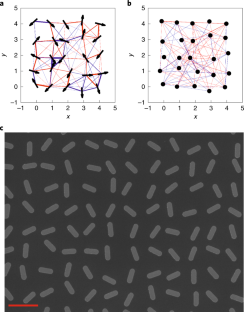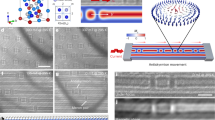Abstract
Spin glasses, generally defined as disordered systems with randomized competing interactions1,2, are a widely investigated complex system. Theoretical models describing spin glasses are broadly used in other complex systems, such as those describing brain function3,4, error-correcting codes5 or stock-market dynamics6. This wide interest in spin glasses provides strong motivation to generate an artificial spin glass within the framework of artificial spin ice systems7,8,9. Here we present the experimental realization of an artificial spin glass consisting of dipolar coupled single-domain Ising-type nanomagnets arranged onto an interaction network that replicates the aspects of a Hopfield neural network10. Using cryogenic X-ray photoemission electron microscopy (XPEEM), we performed temperature-dependent imaging of thermally driven moment fluctuations within these networks and observed characteristic features of a two-dimensional Ising spin glass. Specifically, the temperature dependence of the spin glass correlation function follows a power-law trend predicted from theoretical models on two-dimensional spin glasses11. Furthermore, we observe clear signatures of the hard-to-observe rugged spin glass free energy1 in the form of sub-aging, out-of-equilibrium autocorrelations12 and a transition from stable to unstable dynamics1,13.
This is a preview of subscription content, access via your institution
Access options
Access Nature and 54 other Nature Portfolio journals
Get Nature+, our best-value online-access subscription
$29.99 / 30 days
cancel any time
Subscribe to this journal
Receive 12 print issues and online access
$209.00 per year
only $17.42 per issue
Buy this article
- Purchase on Springer Link
- Instant access to full article PDF
Prices may be subject to local taxes which are calculated during checkout




Similar content being viewed by others
Data availability
The data that support the findings in this study are available in the public repository at https://zenodo.org/record/5879444. Source data are provided with this paper.
Code availability
The code used in this study is available from the authors upon request.
References
Mydosh, J. A. Spin glasses: redux: an updated experimental/materials survey. Rep. Prog. Phys. 78, 052501 (2015).
Binder, K. & Young, A. P. Spin glasses: experimental facts, theoretical concepts and open questions. Rev. Mod. Phys. 58, 801–976 (1986).
Hudetz, A. G., Humphries, C. J. & Binder, J. R. Spin-glass model predicts metastable brain states that diminish in anesthesia. Front. Syst. Neurosci. 8, 234 (2014).
Ezaki, T., Fonseca dos Reis, E., Watanabe, T., Sakaki, M. & Masuda, N. Closer to critical resting-state neural dynamics in individuals with higher fluid intelligence. Commun. Biol. 3, 52 (2020).
Sourlas, N. Spin-glass models as error-correcting codes. Nature 339, 693–695 (1989).
Maskawa, J. in Empirical Science of Financial Fluctuations, 153–158 (Springer, 2002).
Skjærvø, S. H., Marrows, C. H., Stamps, R. L. & Heyderman, L. J. Advances in artificial spin ice. Nat. Rev. Phys. 2, 13–28 (2020).
Saccone, M. et al. Elevated effective dimension in tree-like nanomagnetic Cayley structures. Nanoscale 12, 189–194 (2020).
Saccone, M. et al. Towards artificial Ising spin glasses: thermal ordering in randomized arrays of Ising-type nanomagnets. Phys. Rev. B 99, 224403 (2019).
Hopfield, J. J. Neural networks and physical systems with emergent collective computational abilities. Proc. Natl Acad. Sci. USA 79, 2554–2558 (1982).
Rieger, H. et al. The critical exponents of the two-dimensional Ising spin glass revisited: exact ground-state calculations and Monte Carlo simulations. J. Phys. A 29, 3939–3950 (1996).
Kawashima, N. & Rieger, H. in Frustrated Spin Systems 491–596 (World Scientific, 2005).
Bray, A. J. & Moore, M. A. Chaotic nature of the spin-glass phase. Phys. Rev. Lett. 58, 57–60 (1987).
Wang, R. F. et al. Artificial spin ice in a geometrically frustrated lattice of nanoscale ferromagnetic islands. Nature 439, 303–306 (2006).
Farhan, A. et al. Exploring hyper-cubic energy landscapes in thermally active finite artificial spin-ice systems. Nat. Phys. 9, 375–382 (2013).
Canals, B. et al. Fragmentation of magnetism in artificial kagome dipolar spin ice. Nat. Commun. 7, 11446 (2016).
Gilbert, I. et al. Emergent ice rule and magnetic charge screening from vertex frustration in artificial spin ice. Nat. Phys. 10, 670–675 (2014).
Farhan, A. et al. Thermodynamics of emergent magnetic charge screening in artificial spin ice. Nat. Commun. 7, 12635 (2016).
Lao, Y. et al. Classical topological order in the kinetics of artificial spin ice. Nat. Phys. 14, 723–727 (2018).
Gilbert, I. et al. Emergent reduced dimensionality by vertex frustration in artificial spin ice. Nat. Phys. 12, 162–165 (2015).
Daqing, L., Kosmidis, K., Bunde, A. & Havlin, S. Dimension of spatially embedded networks. Nat. Phys. 7, 481–484 (2011).
Hartmann, A. K. & Young, A. P. Lower critical dimension of Ising spin glasses. Phys. Rev. B 64, 180404 (2001).
Farhan, A. et al. Emergent magnetic monopole dynamics in macroscopically degenerate artificial spin ice. Sci. Adv. 5, eaav6380 (2019).
Stöhr, J. et al. Element-specific magnetic microscopy with circularly polarized X-rays. Science 259, 658–661 (1993).
Berthier, L. & Biroli, G. Theoretical perspective on the glass transition and amorphous materials. Rev. Mod. Phys. 83, 587–645 (2011).
Derrida, B. & Weisbuch, G. Dynamical phase transitions in 3-dimensional spin glasses. Europhys. Lett. 4, 657–662 (1987).
Sompolinsky, H. & Zippelius, A. Relaxational dynamics of the Edwards-Anderson model and the mean-field theory of spin-glasses. Phys. Rev. B 25, 6860–6875 (1982).
Rosenstein, M. T., Collins, J. J. & De Luca, C. J. A practical method for calculating largest Lyapunov exponents from small data sets. Phys. D Nonlinear Phenom. 65, 117–134 (1993).
Yucesoy, B., Machta, J. & Katzgraber, H. G. Correlations between the dynamics of parallel tempering and the free-energy landscape in spin glasses. Phys. Rev. E. 87, 012104 (2013).
Lucas, A. Ising formulations of many NP problem. Front. Phys. 2, 5 (2014).
Perrin, Y., Canals, B. & Rougemaille, N. Extensive degeneracy, Coulomb phase and magnetic monopoles in artificial square ice. Nature 540, 410–413 (2016).
May, A., Hunt, M., van den Berg, A., Hejazi, A. & Ladak, S. Realisation of a frustrated 3D magnetic nanowire lattice. Commun. Phys. 2, 13 (2019).
Li, Y. et al. Programmable ultralight magnets via orientational arrangement of ferromagnetic nanoparticles within aerogel hosts. ACS Nano 13, 13875–13883 (2019).
Farhan, A. et al. Geometrical frustration and planar triangular antiferromagnetism in quasi-three-dimensional artificial spin architecture. Phys. Rev. Lett. 125, 267203 (2020).
Lambson, B., Carlton, D. & Bokor, J. Exploring the thermodynamic limits of computation in integrated systems: magnetic memory, nanomagnetic logic and the Landauer limit. Phys. Rev. Lett. 107, 010604 (2011).
Zhang, X. et al. Understanding thermal annealing in artificial spin ice. APL Mater. 7, 111112 (2019).
Le Guyader, L. et al. Studying nanomagnets and magnetic heterostructures with X-ray PEEM at the Swiss Light Source. J. Electron Spectrosc. Relat. Phenom. 185, 371–380 (2012).
Sendetskyi, O. et al. Continuous magnetic phase transition in artificial square ice. Phys. Rev. B 99, 214430 (2019).
Acknowledgements
We thank A.P. Young for fruitful discussions on estimating the spin glass correlation function’s unbiased estimator. A.F. and K.H. acknowledge support from the Swiss National Science Foundation (projects nos. 174306 and 172774, respectively). Funding was also received from the European Union’s Horizon 2020 research and innovation programme under grant agreement no. 737093, FEMTOTERABYTE. S.v.D. acknowledges support from the Academy of Finland (project no. 316857). M.S. acknowledges the support of the Centre for Nonlinear Studies and Theory Division at Los Alamos (grants nos. PRD20190195 and LA-UR-21-27055). F.C. was also financed via DOE-LDRD grants nos. PRD20170660 and PRD20190195. Part of this project was performed at the SIM Beamline of the Swiss Light Source, Paul Scherrer Institute, Switzerland. Samples were fabricated at the Molecular Foundry, Lawrence Berkeley National Laboratory, USA. The Molecular Foundry is supported by the Office of Science, Office of Basic Energy Sciences, of the US Department of Energy under contract no. DE-AC02-05CH11231.
Author information
Authors and Affiliations
Contributions
M.S. and A.F. conceived the project. A.F. designed and performed the experiments with support from K.H., S.P. and A.K. S.D. fabricated the samples. K.H. fabricated the samples for SQUID magnetometry and Y.A.B. performed the X-ray reflectivity measurements and fitting. M.S. analysed and interpreted the data with support from F.C. and A.F. M.S. and A.F. wrote the manuscript with input from all other authors. S.v.D., C.N. and A.F. supervised the project.
Corresponding authors
Ethics declarations
Competing interests
The authors declare no competing interests.
Peer review
Peer review information
Nature Physics thanks the anonymous reviewers for their contribution to the peer review of this work.
Additional information
Publisher’s note Springer Nature remains neutral with regard to jurisdictional claims in published maps and institutional affiliations.
Supplementary information
Supplementary Information
Supplementary Figs. 1–5. Supplementary Video captions 1–3.
Supplementary Video 1
XMCD image sequence of thermally-activated nanomagnetic Hopfield network recorded at 168 K.
Supplementary Video 2
XMCD image sequence of thermally-activated nanomagnetic Hopfield network recorded at 181 K.
Supplementary Video 3
Schematic representation of low- and high-temperature dynamics within free energy landscapes.
Source data
Source Data Fig. 1
A high-resolution SEM image of the patterned nanomagnetic thin film.
Source Data Fig. 2
High-resolution XMCD images that comprise Fig. 2.
Source Data Fig. 3
The x and y coordinates, along with the error in y, that are plotted in Fig. 3.
Source Data Fig. 4
The x and y coordinates, along with the error in y, that are plotted in Fig. 4.
Rights and permissions
About this article
Cite this article
Saccone, M., Caravelli, F., Hofhuis, K. et al. Direct observation of a dynamical glass transition in a nanomagnetic artificial Hopfield network. Nat. Phys. 18, 517–521 (2022). https://doi.org/10.1038/s41567-022-01538-7
Received:
Accepted:
Published:
Issue Date:
DOI: https://doi.org/10.1038/s41567-022-01538-7
This article is cited by
-
Geometrical control of topological charge transfer in Shakti-Cairo colloidal ice
Communications Physics (2023)
-
Real-space observation of ergodicity transitions in artificial spin ice
Nature Communications (2023)
-
Electrically programmable magnetic coupling in an Ising network exploiting solid-state ionic gating
Nature Communications (2023)
-
Recent progress on coherent computation based on quantum squeezing
AAPPS Bulletin (2023)
-
Glassy net of nanomagnets
Nature Physics (2022)



